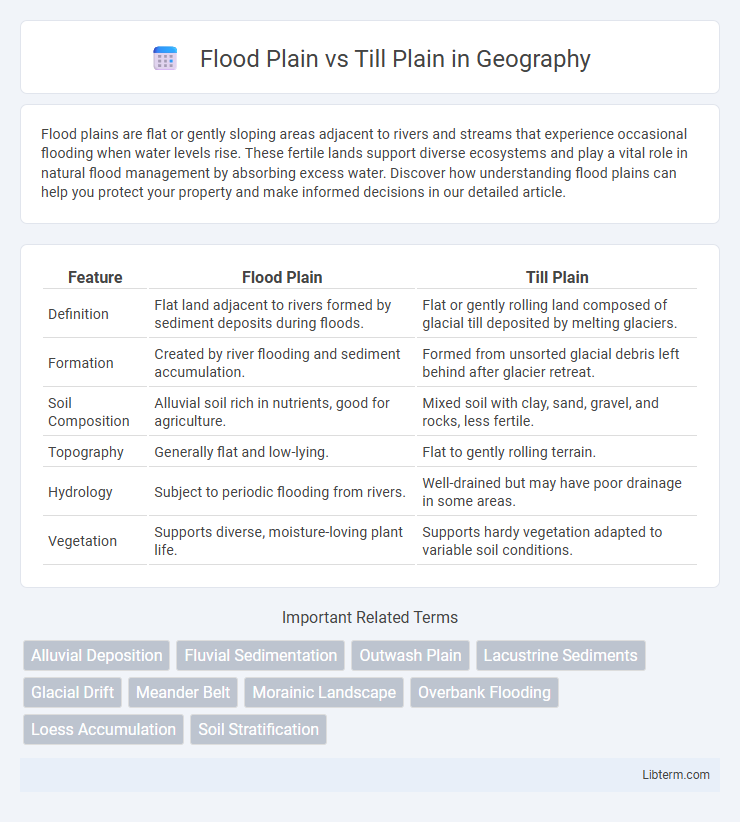Flood plains are flat or gently sloping areas adjacent to rivers and streams that experience occasional flooding when water levels rise. These fertile lands support diverse ecosystems and play a vital role in natural flood management by absorbing excess water. Discover how understanding flood plains can help you protect your property and make informed decisions in our detailed article.
Table of Comparison
| Feature | Flood Plain | Till Plain |
|---|---|---|
| Definition | Flat land adjacent to rivers formed by sediment deposits during floods. | Flat or gently rolling land composed of glacial till deposited by melting glaciers. |
| Formation | Created by river flooding and sediment accumulation. | Formed from unsorted glacial debris left behind after glacier retreat. |
| Soil Composition | Alluvial soil rich in nutrients, good for agriculture. | Mixed soil with clay, sand, gravel, and rocks, less fertile. |
| Topography | Generally flat and low-lying. | Flat to gently rolling terrain. |
| Hydrology | Subject to periodic flooding from rivers. | Well-drained but may have poor drainage in some areas. |
| Vegetation | Supports diverse, moisture-loving plant life. | Supports hardy vegetation adapted to variable soil conditions. |
Introduction to Flood Plains and Till Plains
Flood plains are flat areas adjacent to rivers and streams formed by sediment deposits during flooding, characterized by nutrient-rich soils essential for agriculture and biodiversity. Till plains are expansive landforms created by glacial deposits, composed of unsorted mixtures of clay, sand, gravel, and boulders left behind as glaciers retreat. Understanding these plains is crucial for land use planning, environmental management, and assessing natural hazards.
Key Characteristics of Flood Plains
Flood plains are low-lying areas adjacent to rivers, characterized by periodic flooding that deposits nutrient-rich alluvial soil, making them highly fertile and ideal for agriculture. They exhibit flat terrain with fine sediments like silt and clay, supporting diverse ecosystems and natural water filtration processes. Flood plains also serve as natural buffers, absorbing excess water during heavy rains and reducing flood risks downstream.
Key Characteristics of Till Plains
Till plains are extensive flat or gently rolling landscapes formed by the deposition of glacial till, an unsorted mixture of clay, silt, sand, gravel, and boulders directly deposited by melting glaciers. These plains feature heterogeneous soil composition with poor stratification, contrasting with the well-sorted sediments of flood plains formed by river action. Key characteristics include their origin from glacial activity, presence of irregular topography with drumlins or moraines, and typically fertile but variable soils influenced by the diverse till material.
Formation Processes: Flood Plains
Flood plains form through the natural process of sediment deposition during periodic river overflows, where water spreads across adjacent low-lying areas, depositing layers of silt, sand, and clay. These alluvial deposits accumulate over time, creating fertile, flat land that supports diverse ecosystems and agriculture. The dynamic interplay of erosion and sedimentation driven by river hydrology shapes the flood plain's topography and soil characteristics continuously.
Formation Processes: Till Plains
Till plains form through the deposition of unsorted glacial till directly from melting ice sheets during glacial retreat, resulting in flat or gently rolling landscapes characterized by a mixture of clay, sand, gravel, and boulders. Unlike flood plains, which develop from sediment accumulation in river overflows, till plains lack stratified layers and often feature hummocky terrain shaped by ice stagnation and compaction. These glacial processes create fertile but poorly drained soils, influencing land use and vegetation patterns distinct from those of flood plains.
Soil Composition Differences
Flood plains consist primarily of alluvial soils composed of silt, sand, clay, and organic matter deposited by river flooding, resulting in fertile and well-drained soil ideal for agriculture. Till plains are characterized by unsorted glacial till containing a mixture of clay, sand, gravel, and boulders, leading to heterogeneous soil composition with variable drainage and fertility. The distinct deposition processes define the textural and mineralogical differences influencing soil structure and nutrient availability in flood plains versus till plains.
Biodiversity and Ecosystem Impact
Flood plains support high biodiversity due to frequent nutrient-rich sediment deposits that create diverse wetland habitats, fostering a wide variety of plant and animal species adapted to fluctuating water levels. In contrast, till plains, formed by glacial deposits, have more stable soils promoting grasslands or forests with less hydrological variability, resulting in comparatively lower but still significant biodiversity specialized for nutrient-poor, well-drained environments. The dynamic hydrology of flood plains enhances ecosystem productivity and habitat complexity, while till plains provide critical ecological stability and support resilient terrestrial ecosystems.
Agricultural Potential and Land Use
Flood plains offer rich alluvial soils with high fertility, making them ideal for intensive agriculture, especially for crops requiring ample water supply such as rice and vegetables. Till plains consist of glacial deposits with varied soil texture, often less fertile and requiring soil amendments, but they support diverse land uses including grain farming and pasture. Flood plains are prone to periodic flooding, which replenishes nutrients but necessitates flood management, whereas till plains provide more stable land for long-term cropping and infrastructure development.
Flood Risk and Environmental Concerns
Flood plains are flat areas adjacent to rivers that experience frequent flooding, posing significant flood risk to nearby communities and ecosystems. Till plains consist of glacial deposits with better natural drainage, reducing flood risk but potentially affecting groundwater recharge and soil stability. Environmental concerns include flood plains' susceptibility to habitat disruption and water contamination, while till plains may face challenges related to land use changes and erosion control.
Summary: Comparing Flood and Till Plains
Flood plains form from sediment deposited by rivers during floods, featuring rich, fertile soils ideal for agriculture. Till plains result from glacial deposits of unsorted sediments, creating flat landscapes with a mix of clay, sand, and gravel. Flood plains typically have better water drainage and nutrient content, while till plains may require soil amendments for farming.
Flood Plain Infographic

 libterm.com
libterm.com